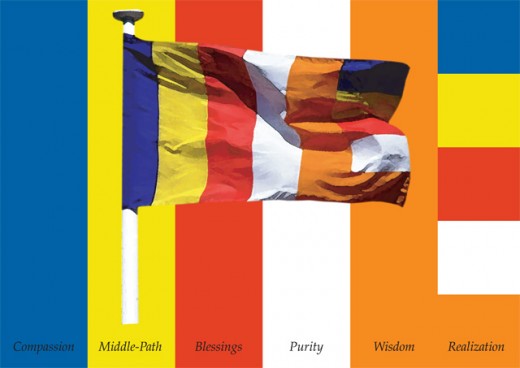
Wesak 2017 is approaching and is on 10 May 2017.
Fly the Buddhist Flag from our Homes to promote awareness for Rational Faith, Global Unity and World Peace, from the Full moon Uposatha on 11 April, one lunar month to Wesak, till the Full moon Uposatha on 9 June 2017, one lunar month after Wesak.
Origin of the Buddhist Flag
The Buddhist Flag, first hoisted in 1885 in Sri Lanka, is a symbol of faith and peace used throughout the world to represent the Buddhist faith.
The Buddhist Flag, first hoisted in 1885 in Sri Lanka, is a symbol of faith and peace used throughout the world to represent the Buddhist faith.
The Buddhist Flag was hoisted for the first time on 28th May 1885, Vesak Full Moon Day, by Ven. Migettuwatte Gunananda Thera at Deepaduththaramaya in Kotahena, Sri Lanka.
Professor G .P. Malalasekera was instrumental in making it the Flag of the Buddhist World. His proposal at the meeting of World Fellowship of Buddhists held in Kandy on 25th May 1950, to accept it as the official Buddhist Flag.
At the World Fellowship of Buddhists conference in 1952, the flag was unanimously adopted by the international delegates as the universal symbol of Buddhist faith. Since then, it has been flown on important occasions and at Buddhist events, especially around Wesak Day.
Meaning of the Colours of the Buddhist Flag
The six colours of the flag represented the colours of the aura that emanated from the body of the Buddha when He attained Enlightenment under the Bodhi Tree.
The six colours of the flag represented the colours of the aura that emanated from the body of the Buddha when He attained Enlightenment under the Bodhi Tree.
The flag comprises six vertical coloured stripes of equal width – blue, yellow, red, white, orange, and a combination of the five colours as the sixth.
The colours symbolize the perfection of Buddhahood and the Dhamma.
The Blue (Nīla) light that radiated from the Buddha's hair symbolises the spirit of Universal Compassion for all beings.
The Yellow (Pīta) light that radiated from the Buddha's epidermis symbolises the Middle Way which avoids all extremes and brings balance and liberation.
The Red (Lohitaka) light that radiated from the Buddha's flesh symbolises the Blessings that the practice of the Buddha's Teaching brings.
The White (Odāta) light that radiated from the Buddha's bones and teeth symbolises the Purity of the Buddha's Teaching and the Liberation it brings.
The Orange (Manjettha) light that radiated from the Buddha's palms, heels and lips symbolises the unshakable Wisdom of the Buddha's Teaching.
The Combination of five Colours, on the fly, symbolises the universality of the Truth of the Buddha's Teaching.
Therefore, the overall flag represents that regardless of race, nationality, division or colour, all sentient beings possess the potential of Buddhahood.
Sources:
www.buddhistcouncilofqueensland.org/node/143
www.nalanda.org.my/the-international-buddhist-flag/
www.nalanda.org.my/history-of-the-buddhist-flag/
www.buddhanet.net/e-learning/history/b_flag.htm
www.buddhistcouncilofqueensland.org/node/143
www.nalanda.org.my/the-international-buddhist-flag/
www.nalanda.org.my/history-of-the-buddhist-flag/
www.buddhanet.net/e-learning/history/b_flag.htm
No comments:
Post a Comment